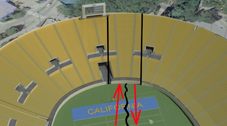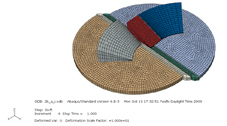
"Fault Rupture Zone Blocks" (FRBs) facilitate independent twisting and tilting resulting from 6' of horizontal and 2' of vertical fault rupture displacement
Built as a memorial to fallen heroes of World War I from California, Memorial Stadium has endured as one of the most picturesque venues in college football from its opening in 1923 for the “Big Game” versus Stanford to present-day. The unique challenge Memorial Stadium posed is that it not only needed to be designed for the strong ground motions, but that it also needed to accommodate potential surface rupture of the Hayward Fault below certain portions of the building.
Through an interdisciplinary effort between structural engineers, geologists, seismologists, and geotechnical engineers, a scheme was designed to accommodate the estimated 6 feet of lateral movement and simultaneous 2 feet of vertical movement that could occur on site. For the Memorial Stadium this meant breaking the seating bowl into discrete ‘fault rupture blocks” (FRB) where the fault crossed, so that these portions of the building could move in response to possible surface rupture without affecting the rest of the structure. A final scheme was developed that satisfied the requirements of all the stakeholders after careful study with advanced finite-element modeling and physical study models.

California Memorial Stadium 375'-long press box can sway up to 12" in a major earthquake
While solving the issue of accommodating surface rupture was an immense engineering challenge, another weighty task also dominated the design of the stadium: the design of a two story, 375 foot long press box that hovers above the seating bowl. While designing a press box on limited supports to give the appearance of “hovering” is difficult enough, the real challenge came in safely bracing this structure for large potential ground motions. The press box structure is designed as a 3D space truss with diagonals in all directions, allowing the structure to cantilever toward the field, span 90 feet between vertical supports, and to be braced seismically between the supporting cores. Even with the extensive bracing, the press box is still relatively flexible when compared with the concrete stadium seating bowl below.
Forell/Elsesser designed a solution that simultaneously provided a separation between the bowl and press box structures and allowed them to move independently with fluid viscous dampers linking them. These dampers would buffer the movements between the two structures, tempering the accelerations in the press box. To protect the tall slender core walls supporting the press box, they needed to rock as a rigid body at their base instead of remaining fixed rigidly to the foundation system. Vertical post-tensioning was utilized in all the cores, allowing them to rock by providing a restoring force and a constant compression force to maintain elasticity. The combination of the vertical post-tensioning and fluid viscous dampers allows the two structures to work together to resist strong ground motions.
With this project complete, Memorial Stadium will be safe for the effects of surface rupture and ground shaking from the Hayward fault while retaining it’s iconic historic façade and providing UC Berkeley with all the amenities of a modern facility. Memorial Stadium will be the envy of the PAC12 and will provide Cal fans with a safe place to spend a fall afternoon cheering on their team.

Abaqus Model
